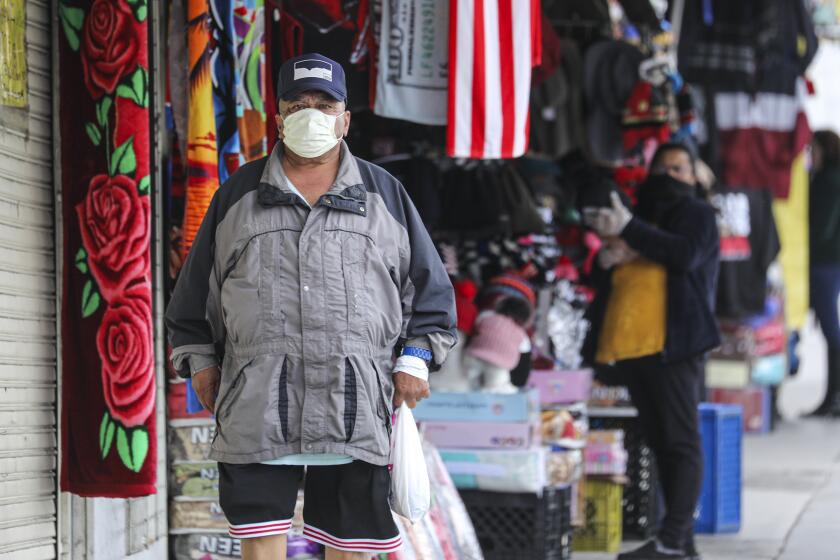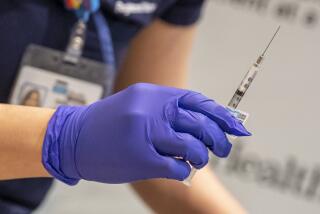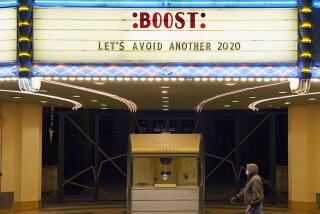Why will it take so long to make a coronavirus vaccine that can prevent COVID-19?
- Share via
Nothing can stop a global outbreak in its tracks better than a vaccine. Unfortunately, creating a vaccine capable of preventing the coronavirus that causes COVID-19 will probably take at least a year to 18 months, health officials say.
“That is the time frame,” Dr. Anthony Fauci, director of the National Institute of Allergy and Infectious Diseases, told the House Oversight and Reform Committee this week. Anyone who says they can do it faster “will be cutting corners that would be detrimental.”
Get the latest coronavirus updates from our staff in California and around the world.
While there are about 10 vaccine candidates in the works — and at least one of them could begin clinical trials in April — it would still take about three more months to conduct the first stage of human testing and another eight months or so to complete the next stage of the trial process, he added.
New vaccines require copious research and time-consuming testing that can cost hundreds of millions of dollars. There’s no guarantee of success, but even if everything goes well, the final product might not hit the market until after an outbreak has subsided.
Here’s a look at how vaccines are made and why the process takes so long.
How does a vaccine work?
Your body has a multi-pronged defense system for recognizing and combating dangerous invaders: your white blood cells. There are several types, each with a different purpose:
• Macrophages engulf and then eat pathogens or cells that are dead or damaged. They leave behind identifying fragments of the invading microbes. These fragments are called antigens.
• B-lymphocytes produce antibodies that recognize and bind to those antigens. If a pathogen with those antigens shows up in the blood stream again, those antibodies can mount an attack.
• If those pathogens are already hiding out inside your cells beyond the antibodies’ reach, T-lymphocytes can attack those infected cells.
Your immune system has to go through this process each time it encounters a threat from a new virus or bacterium.
A vaccine provides a shortcut. Essentially, it helps your immune system learn to recognize a specific threat by tricking it into thinking it’s under attack. Then it can produce the antibodies it needs without having to face a real infection.
Are all vaccines the same?
Nope. The Centers for Disease Control and Prevention describes several types of vaccines:
• Attenuated vaccines, like those for chickenpox and measles, use a live virus or bacteria that has been intentionally weakened so that it can’t cause serious disease in a healthy immune system.
• Inactivated vaccines, such as the one for polio, use germs that have been killed. They typically don’t provide as much immunity as attenuated vaccines, so they may require boosters over time.
• Toxoid vaccines, including the DTaP vaccine for diphtheria and tetanus, use weakened versions of the toxins created by invading bacteria to teach the body how to fight the pathogens.
• Subunit vaccines, such as DTaP’s whooping cough component, only use fragments of the virus or bacterium they protect against.
• Conjugate vaccines teach the immune system to fight bacteria that try to disguise their antigens in the long chains of sugar molecules that form the walls of bacterial cells.
What do you need to know about a virus to create a vaccine?
The immune system learns how to fight a virus by studying its face — the outside of the particle, including those telltale antigens. So a vaccine needs to give your body a snapshot of that face.
One classic technique involves injecting a person with a killed virus. Another uses live viruses that have been grown and deliberately weakened, typically by removing specific genes in their RNA or DNA.
Both of these strategies take some time, and scientists worry that if they use them on novel viruses, they may not behave the way researchers predict, said Dr. Kathryn Stephenson, who runs the clinical trial unit at Beth Israel Deaconess Medical Center’s Center for Virology and Vaccine Research.
Another option for scientists is to reconstruct that snapshot using information from a virus’ genetic code, which may be made of either RNA or DNA.
Nowadays, researchers can get started fast. Scientists in China made the coronavirus’ RNA sequences available on Jan. 10, and many labs began working toward a vaccine the next day, Stephenson said.
Once you know that, is the rest easy?
Hardly. Designing the vaccine is just the first step. Then it has to be produced.
There are many different vaccine-making platforms, each with its own set of advantages and disadvantages.
“What would make a great vaccine for coronavirus is one that you can make quickly and one that would provide long-lasting and effective immunity,” Stephenson said. “Those are not always the same thing.”
For example, a vaccine based on the virus’ genome can be made quickly, in perhaps a month or two, but it may be harder to manufacture in giant quantities.
Another option is to take the virus’ genetic snapshot and put it into a different virus for transport. When introduced into the body, the so-called viral vector vaccine enters cells, prompting them to produce huge numbers of this snapshot for the immune system to see. These vaccines take longer to make — say, six to eight months — but they can be scaled up more readily.
“A lot of us are working on both of those,” Stephenson said.
How are vaccines tested?
Before a vaccine candidate is approved for use, it must be proven safe and effective in a series of trials that are monitored by the Food and Drug Administration.
The first step is to show that it’s safe in preclinical studies. These can be conducted in vitro (using cells in a laboratory dish) or in vivo (using an animal as a stand-in for humans). Finding the right animal for testing can be a challenge, said Robert Grenfell, director of health and biosecurity at CSIRO, Australia’s national science agency, but scientists working on a vaccine for the new coronavirus won’t have to start from scratch. The new virus shares much of its genome with the coronavirus that caused the 2003 outbreak of severe acute respiratory syndrome, and some Australian researchers already have been studying the SARS virus in ferrets.
Then clinical trials in humans can begin. Phase 1 trials are small, usually with a few dozen closely monitored participants. The main goal here is to make sure the vaccine is safe. Phase 2 trials typically enroll hundreds of patients to expand the safety assessment and allow scientists to dig into the body’s immune response. Phase 3 trials can enroll thousands of people, typically with some of them randomly assigned to get the vaccine and some getting a placebo.
This process can take years under normal circumstances. In an emergency, it could be sped up dramatically.
The big sticking point is often the Phase 3 trial. In an epidemic, many study volunteers may not want to risk getting a placebo instead of the vaccine, Stephenson said.
Researchers faced this dilemma during the Western African Ebola outbreak that took off in 2014. The virus had a mortality rate of about 40%, making people desperate for the still-unproven vaccine. So researchers employed a novel experimental design that involved vaccinating people with varying degrees of separation from an Ebola patient and using computer models to help determine if the vaccine had had an effect.
“I think people learned from that that there are ways to be creative,” Stephenson said. A creative solution may be needed when a coronavirus vaccine is ready for Phase 3 testing, she added.
How good does a vaccine need to be in order to gain approval?
The FDA wants it to be both safe and effective — in other words, it has to protect enough people with as few unwanted side effects as possible. But exactly what qualifies as safe and effective may depend on the disease in question.
For some perspective: Stephenson, who also studies HIV, said that researchers would be very happy if they could come up with an HIV vaccine that protected 50% or so of those who got it. On the other hand, for a highly contagious virus like measles, a vaccine would need to work in almost everyone to establish herd immunity, she said.
David Weiner, a molecular immunologist who directs the Wistar Institute’s Vaccine and Immunotherapy Center, said a successful coronavirus vaccine wouldn’t have to be 100% effective.
“I would like us to see it work in the majority of people,” he said, but “if it worked in 50%, 50% is a big improvement over 0%.”
Once a vaccine is approved, is the hard part over?
Definitely not. The labs that create a successful vaccine probably won’t be the ones that are able to scale up — they’ll need a dedicated manufacturer for that part. And many companies may be wary of investing the resources it takes to manufacture a new vaccine when the epidemic could end before there’s a chance to bring it to market, Weiner said.
“Big Pharma is afraid to go in because the outbreaks end and they lose all the money they put in,” he said. That’s why the Oslo-based Coalition for Epidemic Preparedness Innovations, or CEPI, has stepped in with funding to help shepherd some of those efforts, he added.
One of the big technical challenges in large-scale manufacturing is quality control, Stephenson said.
“Every vaccine has its own particular issue,” she said, but “the manufacturing challenges mainly have the most to do with safety precautions and making sure that when you’re done, the vial of vaccine has in it what you say it has.”
Who would get the vaccine first?
This can be a difficult question when there’s a limited amount of vaccine and a whole lot of demand.
Since older adults appear to be most at risk from COVID-19, it’s likely that health officials would focus on them first, Stephenson said.
Medical professionals — who are both at high risk of exposure and are needed to care for those who are sick — would likely be a priority as well.
“Front-line healthcare workers are usually one of the first groups you vaccinate because you need your workforce in place,” she said.
Vaccines are often less effective in older people than they are in younger ones, and this could affect the way that a vaccine is administered. A vaccine might be given in multiple doses, or an adjuvant might be added to it to boost the immune system’s reaction to it.
How can I protect myself until a vaccine is available?
The CDC suggests some common-sense ways for people to protect themselves:
- Avoid close contact with people who are sick.
- Wash your hands often with soap and water for at least 20 seconds.
- If you can’t find soap and water, use an alcohol-based sanitizer with at least 60% alcohol.
- Avoid touching your eyes, nose and mouth.
- Stay home if you’re sick.
- Use a tissue when you cough or sneeze and then throw it away immediately.
- Clean and disinfect frequently touched objects and surfaces.
- Use a face mask if you show symptoms of COVID-19 so you don’t infect others. (The masks are not recommended for healthy people who are just generally trying to protect themselves against infection.)







